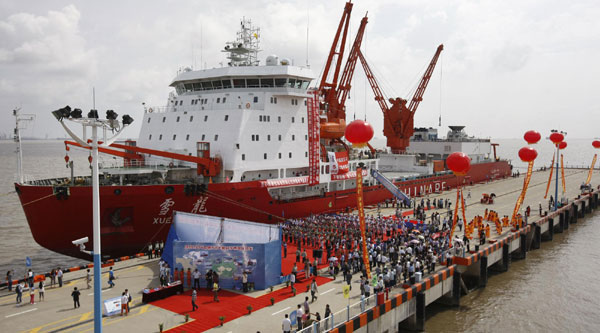Ship completes historic mission
Updated: 2012-09-28 01:41
By Shi Yingying (China Daily)
|
||||||||
 |
|
Chinese icebreakerXuelong, or "Snow Dragon", returned to its Shanghai base on Thursday after finishing the fifth Arctic expedition. [Photo/Xinhua] |
The Chinese icebreaker Xuelong, or Snow Dragon, returned to its Shanghai base on Thursday after wrapping up the country's fifth Arctic expedition with a landmark trip.
The icebreaker, with a 119-member team aboard, completed an unprecedented round trip between the Pacific and the Atlantic via the Arctic route, making it the first Chinese vessel to make a high-latitude voyage across the Arctic Ocean, according to the Polar Research Institute of China.
 |
|
Students hand fl owers to scientists who took part in the Arctic expedition on China’s icebreaker Xuelong, which arrived at Shanghai after accomplishing its mission on Thursday. PEI XIN / XINHUA |
During the three-month voyage, the icebreaker traveled 18,500 nautical miles (34,300 km), including 5,370 nautical miles in the Arctic ice zone.
The institute said the expedition team successfully performed various scientific research tasks, including conducting a systematic geophysical survey, installing an automatic meteorological station, and launching investigations on oceanic turbulence and methane content in the Arctic.
They also held academic exchanges with their counterparts in Iceland, and the two groups conducted a joint oceanic survey in the waters around the island nation.
Xuelong, an A-2 class icebreaker capable of breaking ice 1.2 meters thick, began its journey at the eastern Chinese port of Qingdao on July 2.
In early April, the ship had completed the country's 28th Antarctic expedition after covering 28,000 nautical miles in 163 days.
There are two routes through the Arctic — the Northwest Passage and the Northeast Passage — connecting the Atlantic and Pacific oceans.
Aided by the retreat of Arctic ice that scientists have linked to global warming, Xuelong completed its first trip through the Northwest seaway after channeling through the Arctic's five so-called marginal seas from July 22 to Aug 2: the Chukchi Sea, the East Siberian Sea, the Laptev Sea, the Kara Sea and the Barents Sea.
The Northwest Passage has been increasingly tested globally as a shipping route, but has not yet become a reliable commercial path, with transit limited mainly to military or research craft.
For hundreds of years, mariners have dreamed of an Arctic shortcut that would allow them to speed trade between Asia and the West. As the Arctic has warmed and sea ice in summers has retreated from coasts, countries and companies have become more focused on the resources, trade routes and security issues that are surfacing in what was once an ice-locked backwater.
"It's the longest Arctic expedition we've ever had in terms of both sailing time and distance," said Chen Hongxia, a professor at the State Oceanic Administration's First Institute of Oceanography, who participated in the voyage.
"Unfortunately we didn't reach the North Pole because Xuelong's icebreaking capability isn't strong enough," said Wang Shuoren, political commissar of the icebreaker.
China is designing a new icebreaker, which is scheduled to go into operation in 2014.
The new vessel will be capable of breaking through ice up to 1.5 meters thick and covered with up to 0.2 meter of snow at a speed of 2 to 3 knots.
Xinhua contributed to this story. Contact the writer at shiyingying@chinadaily.com.cn

 Relief reaches isolated village
Relief reaches isolated village
 Rainfall poses new threats to quake-hit region
Rainfall poses new threats to quake-hit region
 Funerals begin for Boston bombing victims
Funerals begin for Boston bombing victims
 Quake takeaway from China's Air Force
Quake takeaway from China's Air Force
 Obama celebrates young inventors at science fair
Obama celebrates young inventors at science fair
 Earth Day marked around the world
Earth Day marked around the world
 Volunteer team helping students find sense of normalcy
Volunteer team helping students find sense of normalcy
 Ethnic groups quick to join rescue efforts
Ethnic groups quick to join rescue efforts
Most Viewed
Editor's Picks

|

|

|

|

|

|
Today's Top News
Health new priority for quake zone
Xi meets US top military officer
Japan's boats driven out of Diaoyu
China mulls online shopping legislation
Bird flu death toll rises to 22
Putin appoints new ambassador to China
Japanese ships blocked from Diaoyu Islands
Inspired by Guan, more Chinese pick up golf
US Weekly

|

|






